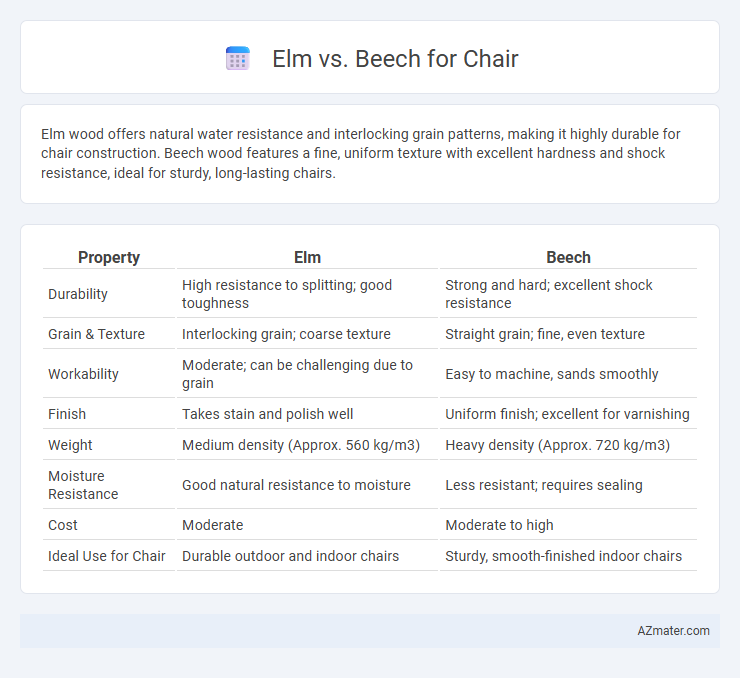Elm wood offers natural water resistance and interlocking grain patterns, making it highly durable for chair construction. Beech wood features a fine, uniform texture with excellent hardness and shock resistance, ideal for sturdy, long-lasting chairs.
Table of Comparison
| Property | Elm | Beech |
|---|---|---|
| Durability | High resistance to splitting; good toughness | Strong and hard; excellent shock resistance |
| Grain & Texture | Interlocking grain; coarse texture | Straight grain; fine, even texture |
| Workability | Moderate; can be challenging due to grain | Easy to machine, sands smoothly |
| Finish | Takes stain and polish well | Uniform finish; excellent for varnishing |
| Weight | Medium density (Approx. 560 kg/m3) | Heavy density (Approx. 720 kg/m3) |
| Moisture Resistance | Good natural resistance to moisture | Less resistant; requires sealing |
| Cost | Moderate | Moderate to high |
| Ideal Use for Chair | Durable outdoor and indoor chairs | Sturdy, smooth-finished indoor chairs |
Introduction to Elm and Beech Wood
Elm wood, known for its interlocking grain and high resistance to splitting, offers excellent durability and shock resistance, making it a preferred choice for chair manufacturing where strength and resilience are critical. Beech wood features a fine, tight grain with a smooth texture, providing stability and ease of machining, resulting in chairs with a clean finish and reliable structural integrity. Both elm and beech exhibit unique properties for furniture making, with elm's toughness complementing beech's hardness and workability.
Origin and Availability of Elm and Beech
Elm wood originates primarily from Europe, North America, and parts of Asia, known for its interlocking grain that provides excellent strength and resistance to splitting, while availability has decreased due to Dutch elm disease affecting many native trees. Beech is native mainly to Europe, with some species in North America and Asia, widely available due to its fast growth and successful cultivation in managed forests. Its consistent grain and hardness make beech a preferred and readily accessible material for furniture like chairs.
Appearance and Grain Patterns
Elm wood features interlocking grain patterns with a wavy or cathedral appearance, offering a unique and lively texture that enhances chair aesthetics. Beech displays a tight, straight grain with a smooth and consistent texture, providing a clean and uniform look ideal for modern or minimalist chair designs. Elm's varied grain contrasts with Beech's even pattern, making each material distinct in visual appeal for furniture crafting.
Strength and Durability Comparison
Elm offers exceptional strength and natural resistance to splitting, making it ideal for chair construction where structural integrity is crucial. Beech provides a dense, hard wood with consistent durability and excellent shock resistance, ensuring long-lasting performance under regular use. While Elm's interlocking grain enhances toughness, Beech's uniform texture allows for smooth finishes and reliable wear resistance, both delivering sturdy chair options with distinct advantages.
Workability and Ease of Shaping
Elm wood offers excellent workability due to its interlocking grain, providing resistance to splitting and making it ideal for curved chair components. Beech is highly favored for ease of shaping and machining, exhibiting uniform texture and smooth surface finish, which allows for precise detailing in chair design. Both woods yield durable furniture, but Beech's consistent grain enhances predictability in cutting, while Elm's toughness provides added structural resilience.
Comfort and Ergonomics in Chairs
Elm wood offers a balanced combination of strength and flexibility, providing natural shock absorption that enhances comfort in chair construction. Beech wood is dense and hard, ensuring stable support and durability, which contributes to ergonomic posture maintenance over prolonged use. Chairs crafted from elm typically feel softer and more forgiving, while beech chairs deliver firmer, more consistent support beneficial for ergonomically designed seating.
Resistance to Wear and Moisture
Elm wood offers excellent resistance to wear due to its interlocking grain, making it highly durable for chair construction, while its moderate moisture resistance helps prevent warping in humid conditions. Beech wood, known for its hard and fine texture, provides superior wear resistance but has lower natural moisture resistance, requiring proper sealing to avoid swelling or damage. Choosing elm is advantageous for moisture-prone environments, whereas beech excels in high-traffic areas needing robust wear endurance.
Maintenance and Longevity
Elm wood offers excellent durability and natural resistance to moisture, making it suitable for chairs requiring low maintenance and long-lasting use. Beech wood is dense and strong but more susceptible to moisture damage, often requiring regular sealing or finishing to maintain its appearance and structural integrity. Longevity favors elm in environments with variable humidity, while beech performs well indoors with controlled conditions.
Cost Differences and Market Value
Elm wood offers moderate cost advantages for chair manufacturing with prices ranging from $7 to $12 per board foot, making it economical compared to premium hardwoods. Beech wood, priced slightly higher at $10 to $15 per board foot, commands better market value due to its durability and fine grain, which enhances chair aesthetics and longevity. Buyers often choose Beech chairs for higher-end furniture markets where durability and appearance justify the increased cost.
Best Applications: Elm or Beech for Chairs
Elm wood is highly valued for chair making due to its interlocking grain, which provides excellent strength and resistance to splitting, making it ideal for robust, durable seating. Beech wood, with its fine grain and smooth texture, is favored for chairs that require a refined finish and increased comfort, excelling in bentwood and upholstered designs. For heavy-use or outdoor chairs, elm is a superior choice because of its toughness, while beech is preferred for indoor chairs that benefit from its workability and aesthetic appeal.

Infographic: Elm vs Beech for Chair
 azmater.com
azmater.com